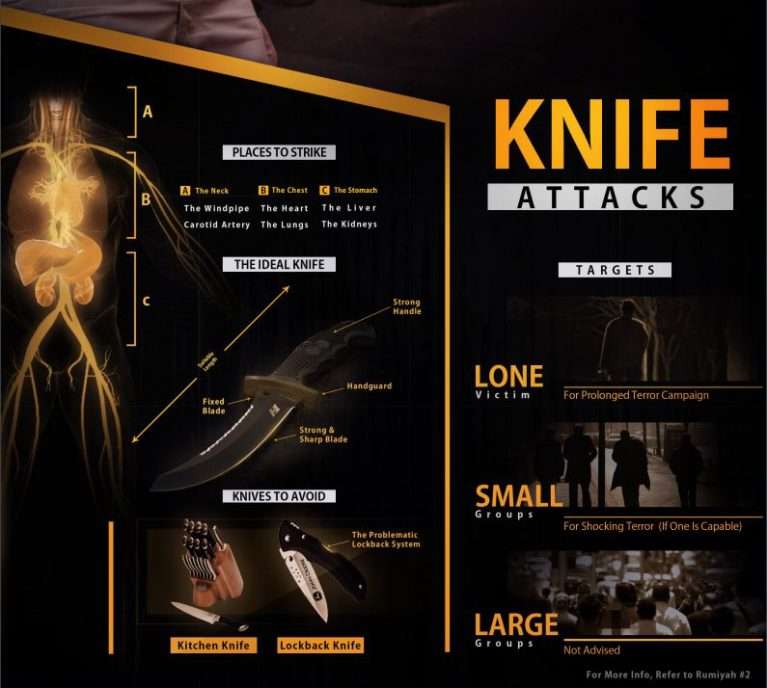“Just Terror Attacks”: what can Rumiyah magazine tell us about ISIS’s plans for domestic terror?

Time appears to be running out for ISIS as a territorial entity. After a stunning international debut, seizing Iraqâs second city of Mosul in the middle of 2014, ISISâs power appeared unstoppable. It appeared to be closing on Baghdad and fanning the flames of war in Syria. Two years later, and it has united the entire world against it and has suffered. In Syria, Syrian government forces ally with Russia, to squeeze the ISIS out of what will remain Assadâs country. In Iraq Western airstrikes pound Mosul as the Iraqi army closes in, eager for revenge. ISIS fighters are retreating to the insignificant town of Raqqa to await the end of the caliphate.
However, ISIS has never just been a place on a map, which can be captured by opposing soldiers. It is also an ideology. In the Middle East this ideology has been spread relatively conventionally: armed occupation of territory, dissemination of propaganda, efforts to build a semi-respectable state apparatus. With this avenue closing, it is likely the ISIS will compensate with a different advertising technique to spread its ideology: terror attacks in the West.
Harry Sarfo became disillusioned with ISIS after joining it in April 2015. On his return to his native Germany (where he awaits trial for terror offences) he revealed that ISISâ violence would not be contained in the Middle East but that acts of terror were actively being planned in Germany, France and the UK.[1] An Iraqi intelligence officer has also stated there are domestic threats to Italy, Denmark and Sweden.[2]
Europol estimates c.5,000 Europeans have been trained in terrorist techniques in Syria, Iraq and possibly the former Soviet bloc. Of these, it is estimated between 400 and 600 have returned to Europe. Sarfo stated that ISIS commanders in Syria and Iraq were most confident of attacks in France occurring, while operatives in Germany and the UK had experienced âcold feetâ and not acted.[3]
One criteria of selection for a return to Europe appears to be a criminal record. Those known to western authorities for terrorist activity fall under too much scrutiny, while those with experience in more common lawbreaking have experience of avoiding police attention as well as, gathering weapons, money and false papers.[4]
Once selected, how does a domestic terrorist to be, return from serving in Syria or Iraq? If he has been sufficiently circumspect, he can simply fly back from a neighbouring country, often Turkey.[5] The alternative is to emulate the hundreds of thousands of refugees who have been compelled to head to Europe due in no small part to ISISâs own actions. Buzzfeed interviewed a Turkey-based people smuggler who said he had been permitted to reveal he transported ISIS fighters to Europe by his ISIS handler.[6] There are also reports of ISIS cells in Libya facilitating boats to Italy in exchange for migrants taking a few ISIS men with them on the journey. [7]
We have seen the damage which can be wrought by domestic terrorists. There has been a spate of violent attacks carried out by Islamists in the last couple of years, such as the Brussels airport bombing and the Paris attacks. The November Paris attack, for which ISIS took credit, was masterminded by Abdelhamid Abaaoud, who claimed to have flitted between Syria and Europe with ease.[8] However, returning fighters are far from the only threat when we discuss domestic danger stemming from ISIS and the Iraq/Syria conflict nexus. There is a second and perhaps more insidious threat: European citizens who have never left their countries, radicalised while thousands of miles from an ISIS training camp and still intent to carry out acts of terror. We can learn much about how ISIS hopes this threat will develop, because ISIS has published these hopes.
Rumiyah magazine is the rebrand of the more famous Dabiq magazine. The rebranding presumably largely due to the embarrassment of naming the magazine after a town ISIS no longer controlls, Dabiq in Syria, but it also is illustrative of a change in ISISâs focus. No longer is the key point territorial control in the Middle East, but instead it is taking the fight to the West: Rumiyah is Arabic for Rome, a synecdoche for the Western powers arrayed against the Caliphate. Previously the cities of Syria were the targets, now it is the cities of the West.
There are two articles in the September edition of Rumiyah magazine of particular interest to us. The first is on the Holey Artisan Bakery terrorist attack in Dhaka, Bangladesh in July 2016. The second is advice on planning a âjust terror attackâ. Together they show ISISâs plans for the future, as well as what they hope to reveal to the rest of the world. In short, Rumiyah hopes to encourage Muslims previously unaffiliated with ISIS to carry out frequent, minor and low tech attacks to spread fear in enemy countries.
Firstly, the magazine justifies attacks on civilians, then it uses shame to drive action:
â¦realize that the Crusader leaders who give the orders to brutally bomb the Muslims donât come from an abstract vacuum; rather, they come into power via the blessings of the constituency of their citizenry, those who partake in their democratic system or accept its results. These Muslims also realize that the huge costs associated with bombs dropped by these aircrafts and drones are largely financed through the tax money generated from the so-called âinnocent civiliansâ of these democratic nations, those âciviliansâ who recognize the legitimacy of policies derived by their democracies, policies including the government spending of tax money on wars waged against Islam and the Muslim
This passage is likely in place to counteract the various Koranic injunctions against attacks on civilians: these civilians are not civilians if they are indirectly supporting the war effort against ISIS.
why have [men] sat back idly â if not cowardly â while the Ummahâs chaste, noble women, for whom jihad is a voluntary and righteous deed, stood in all their bravery to fulfill [sic] the duty of men?
This passage, following a description of female jihadis (including the wife of the San Bernadino shooter), is presumably intended to shame men into action.
But toward what action are they being spurred? The praise of the Holey Bakery attack reveals much about the type of attacker being sought, the ideal target, and the purpose of violence.
Rumiyah praises each attacker involved in the bakery attack, in which 29, including the five attackers, were killed. One trait which is praised is patience (particularly in the youngest of the attackers), alongside piety and courage. This makes sense: ISIS is not necessarily interested in hot-heads if more patient individuals are available, both for operational security and effectiveness. The family backgrounds of the attackers are also discussed. Several were from unexpected backgrounds: Abu Rahiq, the leader, was from a family connected to the ruling Awami party in Bangladesh. Abu Muharib al-Bengali âwas known for his lavish lifestyleâ before turning towards radical Islam. He also tried and failed to serve in the Middle East. Abu Salamah al-Bengali, the youngest, is alleged to have come from an impious family who mocked his devotion. In short, Rumiyah argues that regardless of origin, one can earn redemption through violence. This argument is likely intended to win converts in enemy countries.
Why the Holey Bakery? Rumiyah describes it as a den of vice, frequented by âcrusadersâ and âapostates. It also points out the attackers asked basic religious questions to minimise what it would view as illegitimate targets. Again, we can detect an anticipation of squeamishness when it comes to killing, which in turn indicates an anticipation of non-blooded would-be-terrorists. Turning to the second article, on âjust terror attacksâ, the magazine justifies reluctance to stab a stranger as merely the result of men no longer having to slaughter livestock. Murder is presented as natural, and squeamishness merely due to the softening effects of modern life.
Finally, the magazine writes about knife attacks, and it is specifically knife rather than gun attacks. This is of course useful advice for those looking to operate in Western Europe, where gun laws are relatively tight. Rumiyah has a range of surprisingly practical guidance clearly intended to serve as a methodology. It advocates a straight, non-folding blade with a cross guard. It advocates striking major arteries, especially the throat, but avoiding the skull and denim- or leather-clad parts of the victimâs body. It argues either for attacks on individuals in secluded areas, or on small groups in enclosed spaces, but warns potential attackers away from large groups, which may subdue the attacker before he acts. It advocates leaving a note pinned to the victim, as happened with the murder of Theo van Gogh in 2004, lest the murder seem a random act of violence. It explains the objective as terror, allegedly to deter violence against Muslims (another justification for reluctant attackers â an attack may save lives, not just cost them).[9]
So what does Rumiyah tell us about ISISâs plans for domestic terrorism? We can identify a focus on winning over native Muslims in âenemyâ countries, encouraging them to undertake low cost, high tempo attacks on civilian targets, but also encouraging them to behave patiently to ensure the attack is a success. It aims to exploit Muslim piety, a macho desire not to be outdone by women, and anger at attacks on Muslims perpetrated by the west. It anticipates volunteers who have never drawn blood, and therefore volunteers who must have their squeamishness explained as natural but not a barrier to action.
It should be pointed out Rumiyah is hardly the first publication to encourage this sort of knife attack. The murder of Lee Rigby is an obvious example which predates its publication. However, it is interesting that ISIS is confidently publishing how-to guides for what it must assume is a receptive audience in Europe, Asia and the US. It should also be noted that ISIS knows these magazines are read by people other than its target audience. Although it is probably Rumiyahâs main purpose is to spread ISISâs message, a secondary objective will be to spread fear through its articles threatening knife attacks and encouraging repetitions of the Holey Bakery attack.
Are there ISIS members who have fought in the Middle East in Europe planning attacks? Almost certainly. However, the presence of those radicalised without ever having travelled abroad is a different, and in many ways more sinister threat: a former fighter might be known to Europeâs intelligence services, but a man radicalised online is almost totally unpredictable. As the conflict in the Middle East moves into its end game, it is likely both threats will only increase.
[1] http://www.independent.co.uk/news/world/europe/isis-terrorism-europe-uk-france-germany-harry-sarfo-islam-attack-a7171051.html#gallery
[2] http://www.independent.co.uk/news/world/middle-east/isis-has-at-least-440-fighters-trained-to-attack-europe-in-deadly-waves-a6948696.html
[3] http://www.independent.co.uk/news/world/middle-east/isis-has-at-least-440-fighters-trained-to-attack-europe-in-deadly-waves-a6948696.html
[4] http://www.independent.co.uk/news/world/europe/isis-terrorism-europe-uk-france-germany-harry-sarfo-islam-attack-a7171051.html
[5] http://www.ibtimes.com/how-foreign-fighters-joining-isis-travel-islamic-state-groups-caliphate-1833812
[6] https://www.buzzfeed.com/mikegiglio/isis-operative-this-is-how-we-send-jihadis-to-europe?utm_term=.uyJ8e2gE0#.iwPmE7vW3
[7] http://time.com/3857121/isis-smuggling/
[8] https://www.washingtonpost.com/world/2-attack-suspects-in-dead-after-french-police-raid-north-of-paris/2015/11/18/a2b6d52e-8d6a-11e5-934c-a369c80822c2_story.html?hpid=hp_hp-banner-high_paris%3Ahomepage%2Fstory&utm_term=.b36ebc123c34
[9] https://www.theguardian.com/world/2004/nov/07/terrorism.religion
Report written by Brendan Clifford
